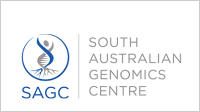_MKC4353.jpg?width=300&name=SAHMRI%20Front%20Entrance_South%20Australian%20Genomics%20Centre%20(SAGC)_MKC4353.jpg)
Support for Australian Biotech
Providing critical genomics infrastructure to support emerging and established players in the growing biotech sector.
The SAGC is part of the Health Innovation Ecosystem in SA
The SAGC is accredited to ISO/IEC 17025 by NATA. A testament to the high quality of our technology and services.
Located in the heart of Adelaide BioMed City – a $3.8B Health Innovation and Translation District – a centrepiece of Australia’s research and innovation ecosystem.

The precinct supports 2000 researchers and 10,000+ staff.




Book a consultation to explore how our genomics capabilities can support your next project.
Why the SAGC?
Best NGS Economics in Australia
The SAGC is the only NCRIS-Bioplatforms supported core facility with the MGI DNBSEQ-T7, capable of sequencing 60 whole genomes per day, and enabling STOmics (spatial transcriptomics).
Complete Toolkit from 10X Genomics
The SAGC is 1 of only 3 reference centres for 10X Genomics in Australia – a leader in spatial and single cell transcriptomics (we offer Chromium, Visium + CytAssist and Xenium).
Dedicated Bioinformatics Team
There to offer support from basic off-the-shelf tools to complex analysis, custom tools and data visualisations.
Key Applications Supporting Drug Discovery
Single Cell Sequencing (scRNA-seq): understanding differential gene expression by cell-type can help inform targets and drug candidates in a variety of ways:
- Improve disease understanding
- Provide insights on cell-type-specific activity
- Better understand cancer development
- Elucidate Off-target effects and heterogeneous responses
- Identify clinically relevant targets and biomarkers
The SAGC offers both microfluidic-based and plate-based combinatorial barcoding technologies as a service. Read More
Spatial Transcriptomics (ST): the addition of spatiotemporal information to gene expression data is enabling researchers to better identify potential drug targets and resistance mechanisms.
- Whole and targeted transcriptome mapping
- Capture dynamics of various pathologies
- Spatial cell distribution in pathogenesis of diseases
- Visualize biomarkers with spatial interactions
- See tumour transcriptomes in their native architecture
- Assist in early disease diagnosis and prognosis


.png?width=300&name=Untitled%20design%20(17).png)

